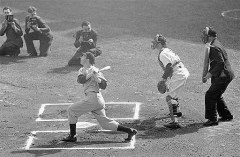| The Math
If math gives you a headache, click here to skip to the results: The processes used for calculating the likelihood of a 56 game streak in a 139 game season, given Joe DiMaggio's actual batting characteristics that year, are simple to understand, if a bit complicated. They involve nothing more advanced than the math you learned in high school. Step 1: The likelihood that one game will include a hit. Before being able to calculate the likelihood of whether a string of games includes a hit in each one, it is necessary to know the likelihood that any one given game includes a hit. Before getting into the specific DiMaggio statistics, it may be a worthwhile memory or learning exercise to review this process with simple numbers. Suppose that a player gets a hit in exactly one third of his plate appearances, and he gets four plate appearances per game. How likely is he to hit in any one game, any two consecutive games, any three, or any 56? His chances of failure in any one plate appearance are 2/3, two out of three. Therefore, his changes of failing four times in a row (a hitless game), will be two-thirds to the fourth power, or 16 times out of every 81 times. As it happens, 81 is exactly half of 162, and 162 is the length of a baseball season, so our hypothetical player is likely to fail to get a hit in 32 games in his hypothetical year. His likely statistical distribution of hits per game is as follows:
This hypothetical player is a great star. Napoleon Lajoie actually had a hitting streak in a season quite similar to this, in 1906. The schedule was shorter then, so he played in only 152 games rather than 162. Lajoie came to the plate 4.16 times per game, and made a hit in 33.9% of his plate appearances. He amassed a 31 game hitting streak that year. For a normal level of player, one who only converts one of every four plate appearances into a hit, the likelihood of a hitless game is about 32%. For a player at the lower end of the spectrum, one who converts only one plate appearance out of five, the likelihood increases to 48% For the purposes of a discussion on streaks, there is no distinction between games with four hits or games with one hit. They all count the same toward a streak. Similarly, a game with three homers counts the same as a game with an infield single. Slugging is as unimportant as multiple hit games. Nor is "on base percentage" relevant. In fact, a walk is equal to an out when calculating the likelihood of a hit streak. Therefore, the key statistic is the likelihood to achieve one or more hits in a game. For the player who hits once per three plate appearances, that likelihood is about 80%, which consists of all games except the 20% when he fails to hit. The one-for-four guy will get a hit in about 68% of his games. The one-for-five player will get a hit in only about 52% of his games. |
|||||||||||||||||||||||||||||||||||||||||||
| In 1941, Joe DiMaggio came to the plate 4.44 times per game, and achieved a hit in 31.3% of his plate appearances. Since he succeeded in getting a hit in 31.3% of his plate appearances, he failed in 68.7%. His likelihood to go hitless in any given game was therefore .687 (4.44), or 18.9%. Looking at the full side of the glass rather than the empty side, he was likely to get a hit in 81.1% of his games. |  |
||||||||||||||||||||||||||||||||||||||||||
|
|
|||||||||||||||||||||||||||||||||||||||||||